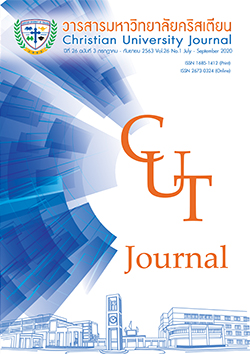อาการคัน ปัจจัยที่เกี่ยวข้อง และการจัดการอาการคันในผู้ป่วยโรคไตเรื้อรังระยะสุดท้าย: บทบาทพยาบาล
คำสำคัญ:
อาการคัน, บทบาทพยาบาล, การจัดการอาการคัน, โรคไตเรื้อรังระยะสุดท้ายบทคัดย่อ
บทความนี้เป็นการทบทวนความรู้เกี่ยวกับอาการคัน ปัจจัยที่เกี่ยวข้อง และการจัดการอาการคันในผู้ป่วยโรคไตเรื้อรังระยะสุดท้ายในบทบาทของพยาบาล ซึ่งอาการคันเป็นปัญหาที่พบได้บ่อยในผู้ป่วยโรคไตเรื้อรังระยะสุดท้าย โดยมีปัจจัยที่เกี่ยวข้องหลายปัจจัย ได้แก่ กลไกทางระบบภูมิคุ้มกัน ภาวะผิวแห้ง การเพิ่มขึ้นของระดับฮีสตามีน ภาวะไม่สมดุลของโอปิออยด์ ภาวะต่อมพาราไทรอยด์ทำงานเกิน โรคปลายประสาทเสื่อม และระยะเวลาที่ได้รับการล้างไต ทั้งนี้อาการคันส่งผลกระทบต่อผู้ป่วยโรคไตเรื้อรังระยะสุดท้ายทั้งด้านร่างกายและจิตใจ และคุณภาพชีวิต ดังนั้นพยาบาลจึงมีบทบาทสำคัญในการจัดการอาการคันในผู้ป่วยโรคไตเรื้อรังระยะสุดท้ายโดยวิธีการจัดการโดยไม่ใช้ยา และการใช้ยาเพื่อช่วยลดอาการคัน มีความสุขสบาย คุณภาพการนอนหลับและคุณภาพชีวิตเพิ่มขึ้น
เอกสารอ้างอิง
Alahi, M., Amin, M., Ali, M., Kafiluddin, M., & Ahmad, Q. (2013). Neuropathy in Chronic Renal Failure. Bangladesh Journal of Neuroscience, 28(2), 116-127. doi:10.3329/bjn.v28i2.17183
Aramwit, P., & Supasyndh, O. (2015). Uremic Pruritus; Its Prevalence, Pathophysiology and Management. Retrieved from: https://www.intechopen.com/books/updates-in-hemodialysis/uremic-pruritus-its-prevalence-pathophysiology-and-Management.
BC Renal Agency. (2017). Management of pruritus in patients with chronic kidney disease. Retrieved from http://www.bcrenalagency.ca/resourcegallery/Documents/Management%20of%20Pruritus%20in%20Patients%20with%20Chronic%20Kidney%20Disease.pdf.
Combs, S. A., Teixeira, J. P., & Germain, M. J. (2015). Pruritus in Kidney Disease. Seminars in nephrology, 35(4), 383–391. doi:10.1016/j.semnephrol.2015.06.009
Eusebio-Alpapara, K. M. V., Castillo, R. L., & Dofitas, B. L. (2020). Gabapentin for uremic pruritus: a systematic review of randomized controlled trials. International Journal of Dermatology, 59(4), 412-422. doi:10.1111/ijd.14708
Feily, A., Dormanesh, B., Ghorbani, A. R., Moosavi, Z., Kouchak, M., Cheraghian, B., . . . Ranjbari, N. (2012). Efficacy of topical cromolyn sodium 4% on pruritus in uremic nephrogenic patients: a randomized double-blind study in 60 patients. International Journal of Clinical Pharmacology and Therapeutics, 50(7), 510-513. doi:10.5414/cp201629
Jaiswal, D., Uzans, D., Hayden, J., Kiberd, B. A., & Tennankore, K. K. (2016). Targeting the Opioid Pathway for Uremic Pruritus: A Systematic Review and Meta-analysis. Canadian Journal of Kidney Health and Disease. 3, 1-9. doi:10.1177/2054358116675345
Lavery, M. J., Kinney, M. O., Mochizuki, H., Craig, J., & Yosipovitch, G. (2016). Pruritus: an overview. What drives people to scratch an itch. Ulster Medical Journal, 85(3), 164-173.
Li, J., Guo, Q., Lin, J., Yi, C., Yang, X., & Yu, X. (2015). Prevalence and Associated Factors of Uraemic Pruritus in Continuous Ambulatory Peritoneal Dialysis Patients. Internal Medicine Journal, 54(22), 2827-2833. doi:10.2169/internalmedicine.54.4516
Min, J.-W., Kim, S.-H., Kim, Y. O., Jin, D. C., Song, H. C., Choi, E. J., . . . Kim, Y. K. (2016). Comparison of uremic pruritus between patients undergoing hemodialysis and peritoneal dialysis. Kidney research and clinical practice, 35(2), 107-113. doi:10.1016/j.krcp.2016.02.002
Nowak, D., & Yeung, J. (2017). Diagnosis and treatment of pruritus. Canadian Family Physician, 63(12), 918-924.
Ozen, N., Cinar, F. I., Askin, D., & Mut, D. (2018). Uremic pruritus and associated factors in hemodialysis patients: A multi-center study. Kidney research and clinical practice, 37(2), 138-147. doi:10.23876/j.krcp.2018.37.2.138
Pakfetrat, M., Basiri, F., Malekmakan, L., & Roozbeh, J. (2014). Effects of turmeric on uremic pruritus in end stage renal disease patients: a double-blind randomized clinical trial. Journal of Nephrology, 27(2), 203-207. doi:10.1007/s40620-014-0039-2
Phan, N. Q., Blome, C., Fritz, F., Gerss, J., Reich, A., Ebata, T., . . . Ständer, S. (2012). Assessment of pruritus intensity: prospective study on validity and reliability of the visual analogue scale, numerical rating scale and verbal rating scale in 471 patients with chronic pruritus. Acta Derm Venereol, 92(5), 502-507. doi:10.2340/00015555-1246
Razeghi, E., Eskandari, D., Ganji, M. R., Meysamie, A. P., Togha, M., & Khashayar, P. (2009). Gabapentin and uremic pruritus in hemodialysis patients. Renal Failure, 31(2), 85-90. doi:10.1080/08860220802595476
Rehman, I. U., & Khan, T. M. (2017). Validity and reliability of the Urdu version of the 5D itching scale to assess pruritus among patients with chronic kidney disease in Pakistan. BMC nephrology, 18(1), 302. doi:10.1186/s12882-017-0717-0
Rehman, I. U., & Khan, T. (2020). Effect of chronic kidney diseases-associated pruritus on patients’ sleep quality, well-being and its management. Progress In Microbes & Molecular Biology, 3(1), 1-6. doi:10.36877/pmmb.a0000067
Satti, M. Z., Arshad, D., Javed, H., Shahroz, A., Tahir, Z., Ahmed, M. M. H., & Kareem, A. (2019). Uremic Pruritus: Prevalence and Impact on Quality of Life and Depressive Symptoms in Hemodialysis Patients. Cureus, 11(7), 1-10. doi:10.7759/cureus.5178
Sherjeena, P. B., Binitha, M. P., Rajan, U., Sreelatha, M., Sarita, S., Nirmal, C., & Deepthi, N. S. (2017). A controlled trial of narrowband ultraviolet B phototherapy for the treatment of uremic pruritus. Indian journal of dermatology, venereology and leprology, 83(2), 247–249. doi: 10.4103/0378-6323.198464
Shirazian, S., Aina, O., Park, Y., Chowdhury, N., Leger, K., Hou, L., . . . Mathur, V. S. (2017). Chronic kidney disease-associated pruritus: impact on quality of life and current management challenges. International journal of nephrology and renovascular disease, 10, 11-26. doi:10.2147/IJNRD.S108045
Song, J., Xian, D., Yang, L., Xiong, X., Lai, R., & Zhong, J. (2018). Pruritus: Progress toward Pathogenesis and Treatment. BioMed Research International, 2018(17), 1-7. 9625936. doi:10.1155/2018/9625936
Swarna, S. S., Aziz, K., Zubair, T., Qadir, N., & Khan, M. (2019). Pruritus Associated With Chronic Kidney Disease: A Comprehensive Literature Review. Cureus, 11(7), e5256. doi:10.7759/cureus.5256
Tajbakhsh, R., Joshaghani, H., Bayzayi, F., Haddad, M., & Qorbani, M. (2013). Association between pruritus and serum concentrations of parathormone, calcium and phosphorus in hemodialysis patients. Saudi Journal of Kidney Diseases and Transplantation, 24(4), 702-706. doi:10.4103/1319-2442.113858
Tarikci, N., Kocatürk, E., Güngör, Ş., Oğuz Topal, I., Ülkümen Can, P., & Singer, R. (2015). Pruritus in Systemic Diseases: A Review of Etiological Factors and New Treatment Modalities. The Scientific World Journal, 2015, 1-8. 803752. doi:10.1155/2015/803752
Verduzco, H. A., & Shirazian, S. (2020). CKD-Associated Pruritus: New Insights Into Diagnosis, Pathogenesis, and Management. Kidney International Reports. doi:https://doi.org/10.1016/j.ekir.2020.04.027
Wu, H. Y., Peng, Y. S., Chen, H. Y., Tsai, W. C., Yang, J. Y., Hsu, S. P., . . . Chiu, H. C. (2016). A Comparison of Uremic Pruritus in Patients Receiving Peritoneal Dialysis and Hemodialysis. Medicine (Baltimore), 95(9), e2935. doi:10.1097/md.000000000000 2935



